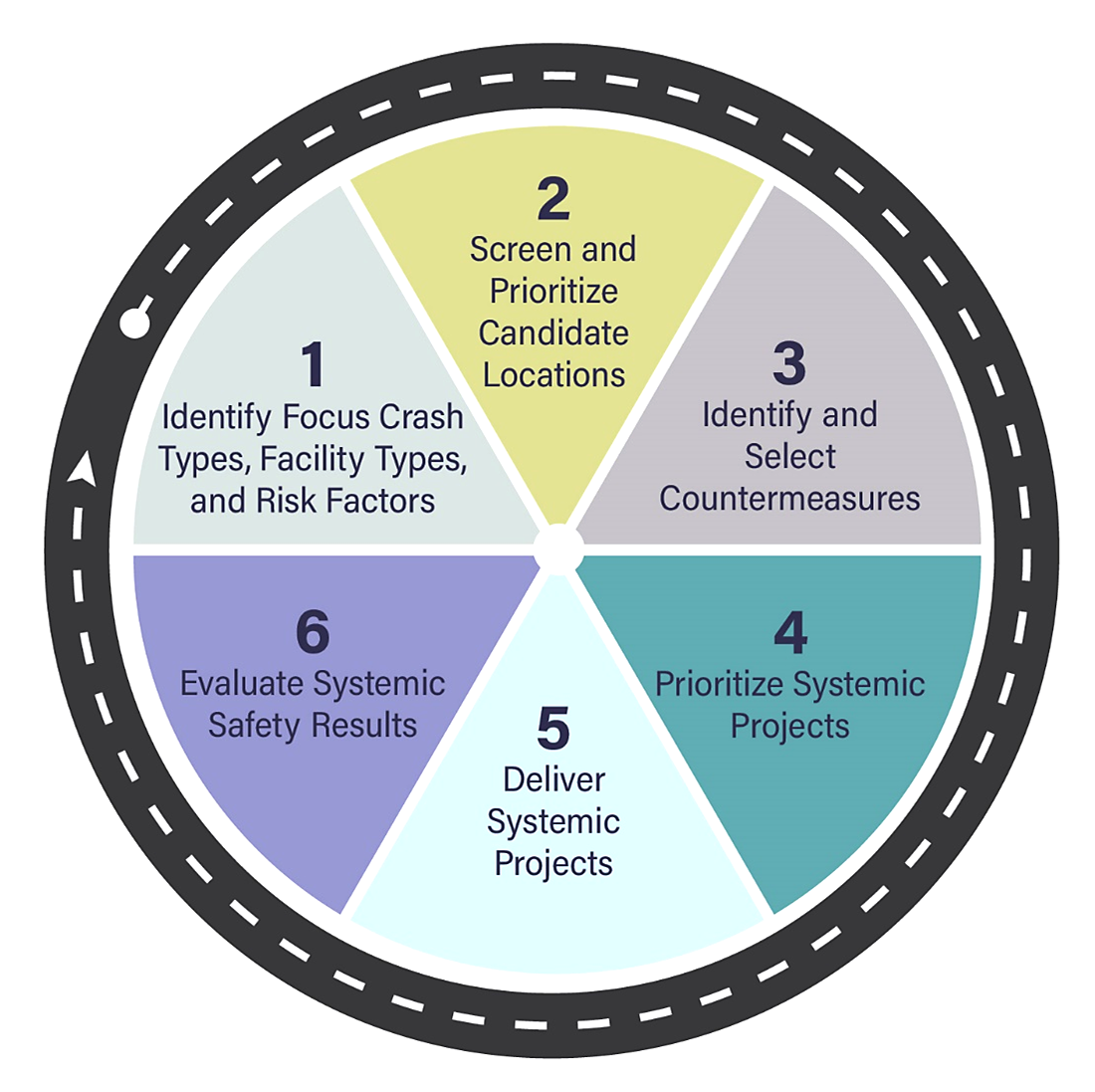
Systemic Safety Analysis: The Power of Prevention
Agencies are advancing a systemic approach to safety analysis to prevent crashes before they happen.
One of the biggest challenges for highway safety practitioners is identifying locations that could become future crash sites and ensuring the best decisions are made on which treatments to implement.
During Every Day Counts (EDC) rounds three and four, the data-driven safety analysis initiative promoted systemic analysis, which uses crash, roadway, traffic data, and more to identify roadway features that correlate with particular crash types. Practitioners can use this data to prioritize safety improvements on roadways proactively, before the next crash occurs.
Transportation agencies at all levels of government are making tremendous progress in incorporating systemic analysis as part of their comprehensive safety management strategies.
Creating Safer Streets for Pedestrians and Bicyclists in Seattle
The Seattle Department of Transportation (SDOT) is using systemic safety analysis to identify high-priority areas for pedestrian and bicyclist safety. This is accomplished through a multi-phase effort that includes the development of pedestrian and bicycle safety performance functions (SPFs) for several specific crash types. The SPF models crash risk and assists SDOT with identifying the risk at various intersections across the city, producing a ranked list of priority locations for treatment.
One of the systemic safety investments identified through the program is leading pedestrian intervals (LPIs). LPIs allow pedestrians to enter an intersection crosswalk 3 to 7 seconds before vehicles are given a green light, increasing pedestrian visibility to drivers. SDOT studied the locations where LPIs had been installed from 2009 to 2018 and found a 48-percent reduction in turning movement pedestrian crashes and a 34-percent reduction in serious injury and fatal pedestrian collisions.
Seeing their effectiveness, SDOT began implementing LPIs across the city in 2018 using a systemic prioritization approach. In 2019, SDOT adopted a new policy to evaluate adding an LPI every time they build a new traffic signal or do other signal maintenance work that provides an opportunity to make this upgrade. This is an example of how a systemic countermeasure can sometimes progress to become a systematic countermeasure, where it is considered for all locations based on policy or other agency criteria.

The six-step process of applying the systemic approach to safety.
Credit: FHWAImproving Project Evaluation in the Atlanta Region
The Atlanta Regional Commission (ARC) has incorporated a systemic safety approach into the agency’s project evaluation process for its Transportation Improvement Program (TIP).
A few years ago, ARC embarked on a mission to have a Regional Safety Strategy with a data-informed perspective. They found that the types of crashes overrepresented in fatalities and serious injuries in the region involved intersections, a car running off a road or leaving its lane, and pedestrians or cyclists. ARC identified several risk factors for why these crashes occurred historically and applied the factors to every road in the region. The agency then produced a Risk Factors Web Map that shows corridors and intersections at high risk for severe crashes based on the presence of roadway design characteristics and other data.
ARC Transportation Planner Tejas Kotak said the analysis has helped the agency better understand which projects will best adhere to their safety goals and reduce unnecessary deaths and injuries in the region.
“This was a really important factor for us in deciding which projects to fund during this round of our TIP solicitation, and it’s something that we’re going to continue tweaking as we do more TIP solicitations and project reviews,” he said.
Watch an FHWA video for an overview of the systemic approach to safety analysis.
Credit: FHWATargeting Safety Program Funds in Ohio
In 2022, the Ohio DOT (ODOT) launched a new annual application for Highway Safety Improvement Program (HSIP) funding that began with a systemic safety analysis.
To identify a priority network for implementation of systemic projects, ODOT began with two crash types: roadway departure and pedestrian crashes. They used a machine learning-enabled analysis process to identify where specific roadway characteristic bundles were present, indicating the highest risk for a serious crash for the two crash types. ODOT then took the output from the model and created a Geographic Information System (GIS) -based map of the agency’s priority segments and corridors eligible for systemic improvements.
For the HSIP application, local agencies can access this map and identify specific points along ODOT’s priority segments where they would like to implement a project. They then select a recommended countermeasure from ODOT’s multimodal design guide based on the location’s existing or desired geometrics.
Most of the applications ODOT awarded in the program’s first year are now beginning construction or being completed, so over the next couple years ODOT is planning to conduct a performance evaluation to gauge the program’s success in terms of reducing fatal and serious injury crashes.
Jeremy Thompson, ODOT Highway Safety Program Engineer, said the agency invests in other systemic initiatives as well, including countermeasures such as rumble strips, SafetyEdgeSM, and reflective backplates.
“A lot of the things that in the past we’ve started as systemic have become more systematic in nature,” said Thompson, “and they’re now just a part of our everyday processes when we go to program and implement projects.”
—MORE INFORMATION
Visit the FHWA Systemic Approach to Safety webpage for additional noteworthy practices and case studies.
Contact Matt Hinshaw, FHWA Office of Safety, or Derek Troyer, FHWA Resource Center, for information and technical assistance, including a one-day workshop training opportunity.
Disclaimer: The U.S. Government does not endorse products or manufacturers. Trademarks or manufacturers’ names appear in this document only because they are considered essential to the objective of the document. They are included for informational purposes only and are not intended to reflect a preference, approval, or endorsement of any one product or entity.
Except for the statutes and regulations cited, the contents of this document do not have the force and effect of law and are not meant to bind the States or the public in any way. This document is intended only to provide information regarding existing requirements under the law or agency policies.
Recommended Citation: U.S. Department of Transportation, Federal Highway Administration - Washington, DC (2025) Innovator Newsletter, March/April 2025, Volume 18 (103). https://doi.org/10.21949/xj4k-9v21
- Cover
- From Simulation to Reality: Puerto Rico’s First Diverging Diamond Interchange
- Concrete Innovation: ODOT’s Strategic Approach to Internal Curing
- EDC Legacy: Collaborating to Solve Road Data Challenges
- Systemic Safety Analysis: The Power of Prevention
- States Innovate
- Enhance Concrete Performance with Internal Curing
- About Innovator


